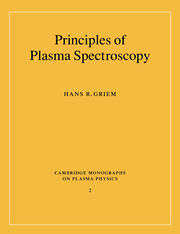Book contents
- Frontmatter
- Contents
- Preface
- Symbols
- 1 Classical theory of radiation
- 2 Quantum theory of radiation
- 3 Oscillator and line strengths
- 4 Spectral line broadening
- 5 Continuous spectra
- 6 Cross sections and level kinetics
- 7 Thermodynamic equilibrium relations
- 8 Radiative energy transfer
- 9 Radiation losses
- 10 Spectroscopic density measurements
- 11 Spectroscopic temperature measurements
- 12 Other diagnostic applications of plasma spectroscopy
- References
- Index
8 - Radiative energy transfer
Published online by Cambridge University Press: 29 August 2009
- Frontmatter
- Contents
- Preface
- Symbols
- 1 Classical theory of radiation
- 2 Quantum theory of radiation
- 3 Oscillator and line strengths
- 4 Spectral line broadening
- 5 Continuous spectra
- 6 Cross sections and level kinetics
- 7 Thermodynamic equilibrium relations
- 8 Radiative energy transfer
- 9 Radiation losses
- 10 Spectroscopic density measurements
- 11 Spectroscopic temperature measurements
- 12 Other diagnostic applications of plasma spectroscopy
- References
- Index
Summary
In the preceding chapters, the basic radiative and collisional processes governing local radiative properties of a plasma were introduced; and their quantitative evaluation or acquisition was discussed to help the reader in the selection of data needed for analysis or prediction of a spectrum. We also learned about various kinetic or thermodynamic models designed for comprehensive descriptions of level populations.
There are two reasons for this seemingly all-encompassing body of theory and basic data to be insufficient, nevertheless, for both analysis and predictions. First, one generally cannot measure local values of the plasma emission, but must infer them from some distance and averaged over the various contributing volume elements. Second, and even more fundamentally, radiative processes also influence level populations so that the emission or absorption in one location depends on the radiation flux coming from the rest of the plasma.
Therefore a self-consistent treatment of radiation transport and level populations is necessary, requiring in general a nonlocal and nonlinear theory. Such theory has been developed over many years, mainly by astronomers and astrophysicists. Much progress has been made after the two basic treatises (Chandrasekhar 1950 and Sobolev 1963) were written, mostly by computational methods (see, e.g., Athay 1972, Kalkofen 1984, Crivellari, Hubeny and Hummer 1991), but also through more or less analytic models (see, e.g., Thomas and Athay 1961, Jefferies 1968, Ivanov 1973).
- Type
- Chapter
- Information
- Principles of Plasma Spectroscopy , pp. 221 - 243Publisher: Cambridge University PressPrint publication year: 1997
- 1
- Cited by

